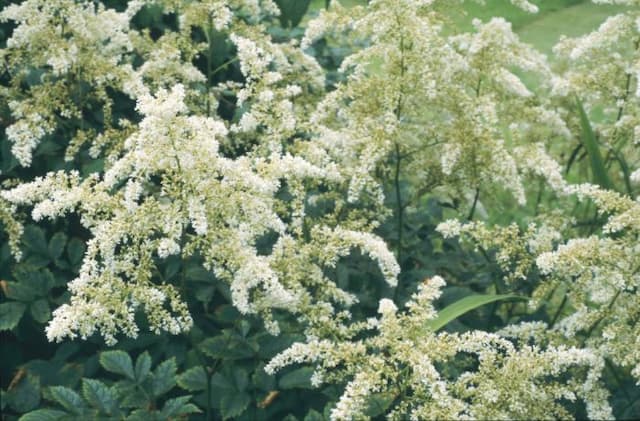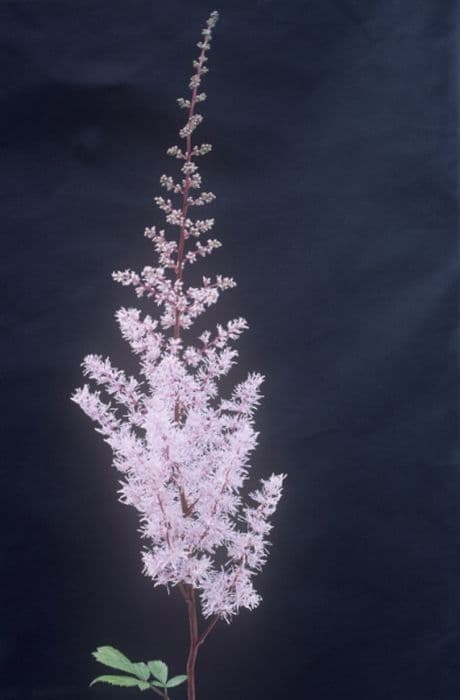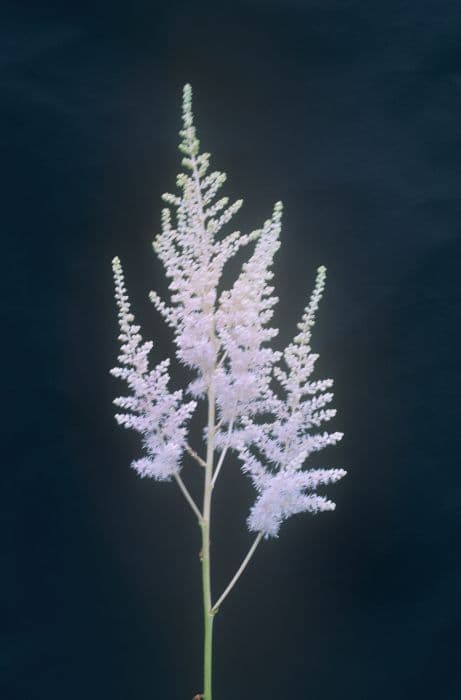Foamy Bells × Heucherella Gold Strike = 'Hertn041'
![heucherella [Gold Strike]](/_next/image?url=https%3A%2F%2Fplants-admin.emdemapps.com%2Fimages%2Fplants%2F%2Fimages%2F604b5df0ebe4e.png&w=3840&q=75)
ABOUT
The × Heucherella Gold Strike, also known as foamy bells, is a visually captivating perennial plant that features a unique combination of foliage and flowering traits. The leaves of the Gold Strike are particularly striking due to their intricate variegation and coloration. Each leaf showcases a bold palette that includes deep green and vibrant gold, arranged in a pattern that can appear almost marbled. The contrasting colors make the foliage shimmer and stand out in any garden composition. The leaves themselves have a lobed and somewhat rounded shape, giving them a lush and full appearance. They grow in a mounding habit, creating a visually dense cluster of variegated foliage that adds both texture and color interest to the plant's overall appearance. Throughout the flowering season, foamy bells produce delicate blooms that rise above the foliage on slender stems. These flowers tend to be small and airy, typically in shades of white or light pink, creating a soft, cloud-like effect. The blooms bring an additional layer of visual appeal and can attract pollinators such as bees and butterflies. While the flowers are charming, it is often the striking appearance of the Gold Strike's foliage that garners the most attention, making it a popular choice for gardeners looking to add a touch of variegated color to their landscape. The plant exhibits a vibrant and decorative presence, perfect for use in garden borders, containers, or as ground cover.
About this plant
 Names
NamesFamily
Saxifragaceae
Synonyms
Foamy Bells, Heucherella Gold Strike
Common names
× Heucherella Gold Strike = 'Hertn041'.
 Toxicity
ToxicityTo humans
The plant commonly known as Foamy Bells 'Gold Strike' is not known to be toxic to humans. Therefore, ingestion of this plant typically does not result in poisoning or adverse symptoms.
To pets
Foamy Bells 'Gold Strike' is not known to be toxic to pets. It is generally considered safe, and ingestion should not lead to poisoning or harmful symptoms in animals such as cats and dogs.
 Characteristics
CharacteristicsLife cycle
Perennials
Foliage type
Semi-evergreen
Color of leaves
Variegated
Flower color
White
Height
1 foot (30 cm)
Spread
2 feet (60 cm)
Plant type
Herb
Hardiness zones
4
Native area
North America
Benefits
 General Benefits
General Benefits- Attractive Foliage: × Heucherella 'Gold Strike' boasts colorful leaves that add visual interest to gardens.
- Seasonal Interest: It offers year-round interest with its evergreen or semi-evergreen foliage, depending on the climate.
- Low Maintenance: This plant typically requires less care once established, making it a good choice for gardeners of all levels.
- Drought Tolerance: Once established, it can tolerate dry conditions, minimizing the need for frequent watering.
- Versatile Use: It can be used in a variety of garden settings, such as borders, ground cover, or container gardens.
- Attracts Wildlife: The flowers can attract pollinators like bees and butterflies to the garden.
- Deer and Rabbit Resistance: The plant is often resistant to browsing by deer and rabbits, preventing damage.
- Tolerance of Different Soil Types: It can adapt to a range of soil conditions, though it prefers well-draining soils.
 Medical Properties
Medical PropertiesThis plant is not used for medical purposes.
 Air-purifying Qualities
Air-purifying QualitiesThis plant is not specifically known for air purifying qualities.
 Other Uses
Other Uses- Crafting: The vibrant foliage of × Heucherella 'Gold Strike' can be used in creating botanical art pieces or for embellishing handmade greeting cards.
- Seasonal Decorations: The leaves can be incorporated into fall or Halloween-themed decorations, due to their striking colors.
- Education: This hybrid plant can be used as an example in educational settings to explain plant hybridization and genetic traits between species.
- Photography: The plant provides a photogenic subject for garden photography and can help hobbyists practice macro and nature photography.
- Pressed Flowers: Leaves from the Heucherella 'Gold Strike' can be pressed and used for decorative purposes in scrapbooking or bookmark making.
- Culinary Garnish: While not meant to be consumed, the decorative leaves can be used to adorn plates or buffet tables at garden-themed parties (care should be taken to ensure they are not ingested).
- Color Dyes: The pigments of the leaves can potentially be used to create natural dyes for fabrics or papers, though experimentation may be required.
- Companion Planting: Heucherella 'Gold Strike' can act as a companion plant in the garden by creating a contrasting backdrop for other flowering plants.
- Mood Boards: Cuttings from the plant can be added to mood boards for garden design or interior decor to illustrate color schemes or textures.
- Ikebana: The Japanese art of flower arrangement, Ikebana, may use the structural leaves of Heucherella 'Gold Strike' to add visual interest to compositions.
Interesting Facts
 Feng Shui
Feng ShuiThe plant Foamy Bells is not used in Feng Shui practice.
 Zodiac Sign Compitability
Zodiac Sign CompitabilityThe plant Foamy Bells is not used in astrology practice.
 Plant Symbolism
Plant Symbolism- Innovation: The Heucherella Gold Strike, also commonly known as Foamy Bells, is a hybrid plant, created by combining two different species. As such, it symbolizes the ingenuity and creativity involved in innovation.
- Vitality: With its vibrant gold and green foliage, Foamy Bells represent energy and the zest for life, embodying the essence of vitality.
- Prosperity: The golden hues of the plant's leaves can be seen as a symbol of wealth and prosperity, making it a positive emblem for financial success.
- Beauty: Foamy Bells' attractive appearance and the charm of its foliage make it a symbol of beauty and the appreciation of visual aesthetics.
- Adaptability: Being a hybrid that can thrive in various conditions, Foamy Bells symbolize adaptability and the ability to flourish in diverse environments.
 Water
WaterTo maintain the Foamy Bells, or Heucherella 'Gold Strike', water the plant thoroughly when the top inch of soil feels dry. In general, this can be equivalent to approximately 1 inch of water per week, but this may vary depending on climate and soil conditions. It's best to water deeply and less frequently to encourage root growth. Over the course of a month, aim to provide about 4 gallons, adjusting for rainfall and temperature. Avoid overhead watering to minimize leaf wetness and potential disease issues.
 Light
LightFoamy Bells flourishes in partial to full shade. It is ideally placed in a location where it can receive dappled sunlight or light shade for most of the day. Direct afternoon sun should be avoided as it can scorch the leaves. A north-facing or east-facing spot with filtered light is perfect for this plant.
 Temperature
TemperatureFoamy Bells can tolerate a wide temperature range. They perform best in conditions between 60°F and 80°F, which typically corresponds to spring and fall seasons. They can survive minimum temperatures of approximately 20°F and should be protected from extreme heat above 90°F.
 Pruning
PruningPrune Foamy Bells in late winter or early spring to remove any dead or damaged foliage and to maintain its shape. Trimming off spent flower stems after blooming can encourage a second flush of flowers. Pruning is typically done on an annual basis, and the best time is right before new growth starts.
 Cleaning
CleaningAs needed
 Soil
SoilFoamy Bells 'Gold Strike' thrive in moist but well-drained soil with rich organic matter. A mix of loam, peat, and perlite works well for potting. Maintain a soil pH range of 5.5 to 6.5 for optimal growth.
 Repotting
RepottingFoamy Bells 'Gold Strike' typically need repotting every 2-3 years to refresh the soil and accommodate root growth. Do this in spring or fall when the plant is not in active growth.
 Humidity & Misting
Humidity & MistingFor Foamy Bells 'Gold Strike', maintain a moderate humidity level around 50%. They do not require high humidity but avoid extremely dry air.
 Suitable locations
Suitable locationsIndoor
Place in bright, indirect light and keep soil consistently moist.
Outdoor
Plant in partial shade with well-draining, fertile soil.
Hardiness zone
4-9 USDA
 Life cycle
Life cycle× Heucherella Gold Strike, commonly known as Foamy Bells, begins its life as a seed, which germinates when conditions of warmth and moisture are met. The seedling develops into a rosette of leaves, establishing a root system and gradually producing foliage that showcases its characteristic golden color. As it matures, Foamy Bells produce flower stalks that rise above the foliage, blooming with small, delicate flowers that can attract pollinators. After pollination, seeds are formed and dispersed, either by wind or wildlife, enabling the cycle to start anew. In the right conditions, Foamy Bells can also spread vegetatively through stolons, thereby expanding its presence in its growing area. Throughout the seasons, this perennial plant dies back in winter, surviving as roots and crowns, before regrowing in spring to repeat its life cycle.
 Propogation
PropogationPropogation time
Spring-Early Summer
Propogation: × Heucherella Gold Strike, more commonly known as Heucherella, is best propagated through the division of its clumps. The ideal time to undertake this method is either in the early spring as the plant emerges from dormancy or in the late fall when the plant has finished flowering and is preparing for winter. Division involves carefully digging up the plant, ensuring you have a sizeable portion of the root system. Once the plant is unearthed, use a sharp knife or spade to gently separate the clump into smaller sections, each with a portion of root and several shoots. These sections can then be replanted at the same depth they were previously growing in well-draining soil, spaced about 15 to 18 inches (approximately 38 to 46 centimeters) apart. This method allows for quick establishment and proliferation of new plants in the garden.









